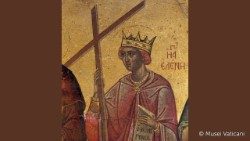SAINT OF THE DAY, ST. HELENA, EMPRESS, ST AGAPITUS, MARTYR OF PALESTRINA, Aug. 18
ST. HELENA, EMPRESS
It was the richness of soul, more than material wealth and prestige, that characterized the actions of Saint Helena, and that even before her conversion as an adult. Humility, generosity, and dedication to her neighbor emerge from the scant information we have available about her life.
Humble origins, marriage, and the birth of Constantine
Helena was probably born in the middle of the third century, in the town of Drepanum in Asia Minor. Later, after her son had become Emperor, the town was renamed Helenopolis in her honour. According to St Anselm, as a young woman she worked as a stable maid. Helena’s modesty and virtue attracted the attention of a young Roman official, Constantius Chlorus, who took her as his wife in spite of the difference in their social status. She accompanied Constantius to Balkans, and sometime after the year 270, gave birth to her only son, Constantine.
Divorce and obscurity
Constantius continued to rise through the ranks of the Roman military, and eventually received the title of “Caesar” in the political system known as the Tetrarchy, under the co-emperors Diocletian and Maximian. At that time, for political reasons he was forced to repudiate Helena, and marry Maximian’s daughter. Far from her family, and from the son she had raised with dedication and love, Helena nonetheless never lost hope. She remained in the shadows as her son rose to a place in the court of Diocletian.
Augusta, mother of the Emperor, humble protector of the poor
Constantius Chorus became Augustus (senior emperor) in 305, and Constantine followed him to Britain, where he took part in the campaign against the Picts. When his father died unexpectedly at York, Constantine was acclaimed as emperor by his army. One of the new emperor’s first actions was to recall his mother Helena, and confer on her the honorary title of Augusta.
It was shortly after her son’s accession that Helena converted to Christianity. Her newfound faith caused her native virtues to flourish, and she used her position to care for the poor, providing for their needs through generous almsgiving; and to liberate prisoners, and those sent to the mines or into exile. Her faith likely provided inspiration to Constantine, who in 313 promulgated the Edict of Milan, which allowed Christians to worship freely. During the celebrations that followed, it was said that Helena dressed in modest clothing in order to join the crowds, and that she fed the poor with her own hands
The discovery of the True Cross
Constantine’s reign, however, was not uniformly happy. In 326, he ordered the death of his son Crispus, and a short time later, that of his second wife, Fausta. In the face of this family tragedy, Helena maintained her faith, and in the year 326, she began a pilgrimage to the Holy Land. There she ordered the construction of the Basilicas of the Nativity in Bethlehem, and of the Ascension on the Mount of Olives. She prompted her son to build a Basilica over the sites where Jesus had died and risen from the dead.
After clearing away the pagan edifices that had been built on the site, the workers began construction of the Basilica. The work was overseen by Helena, who hoped to discover the relics of Christ’s Passion. Her faith was rewarded when the True Cross was discovered. The identity of the Cross was confirmed when a dead man laid on the wood was miraculously restored to life. The three nails from the Crucifixion were given by Helena to Constantine. One was cast into the Iron Crown, as a reminder that there is not rule which should not be subject to God; the Crown currently rests in the Cathedral of Monza, in Italy. The other precious relics of the Crucifixion are today preserved in the Roman Basilica of the Holy Cross in Jerusalem (Santa Croce in Gerusalemme).
Helena died in the year 329 in an unknown location. Constantine had her body brought back to Rome; she was buried in mausoleum named for her on the Via Labicana. Her porphyry sarcophagus, which was moved to the Lateran in the eleventh century, can now be seen in the Vatican Museums.
Devotion to St Helena spread throughout the East and the West, where she is commemorated on 21 May and 18 August respectively. Iconographically, she is associated with the Cross. Along with Saints Andrew, Veronica, and Longinus, she was chosen for one of the pilasters that support the great dome of St Peter’s.


Comments
Post a Comment